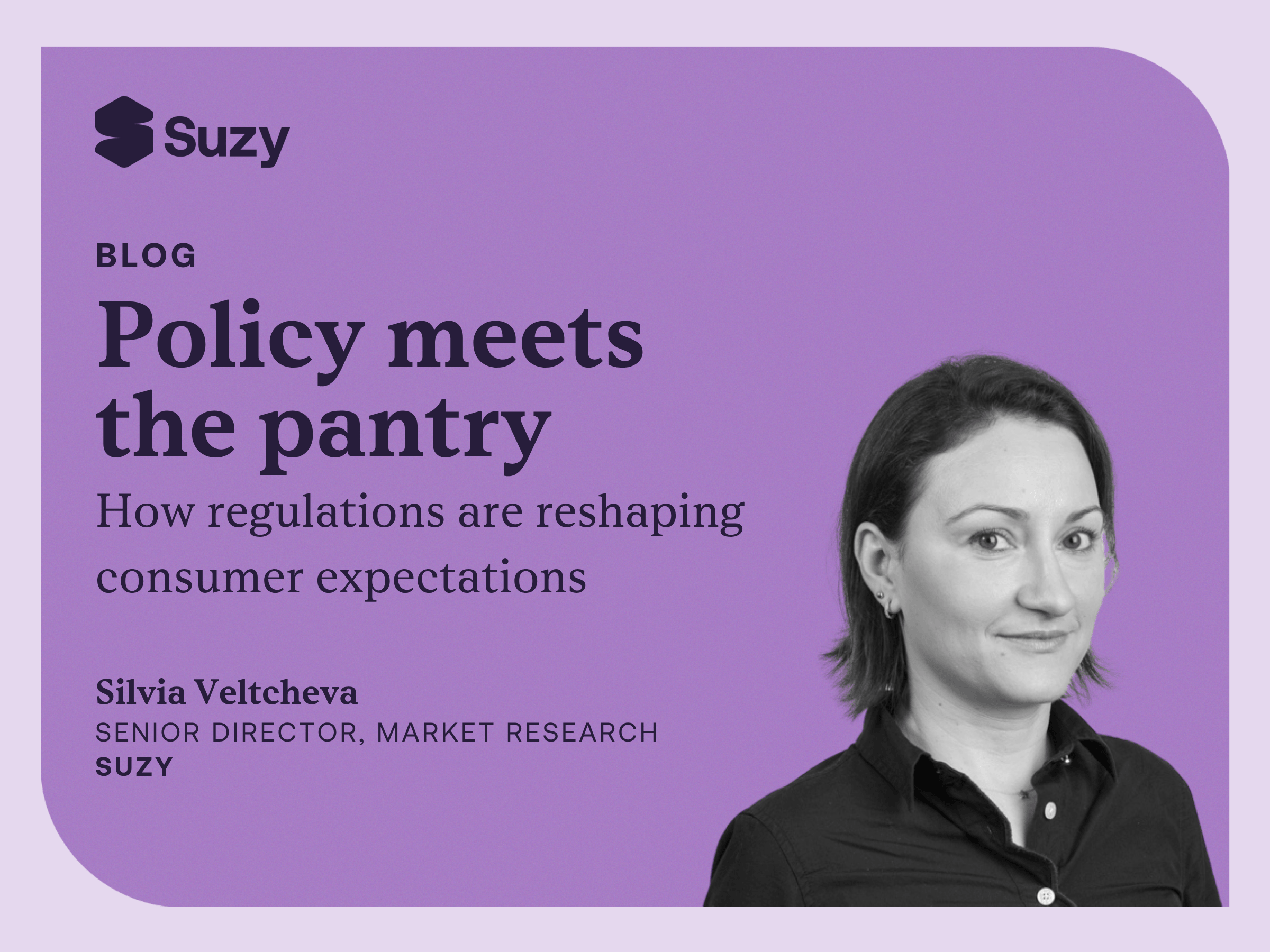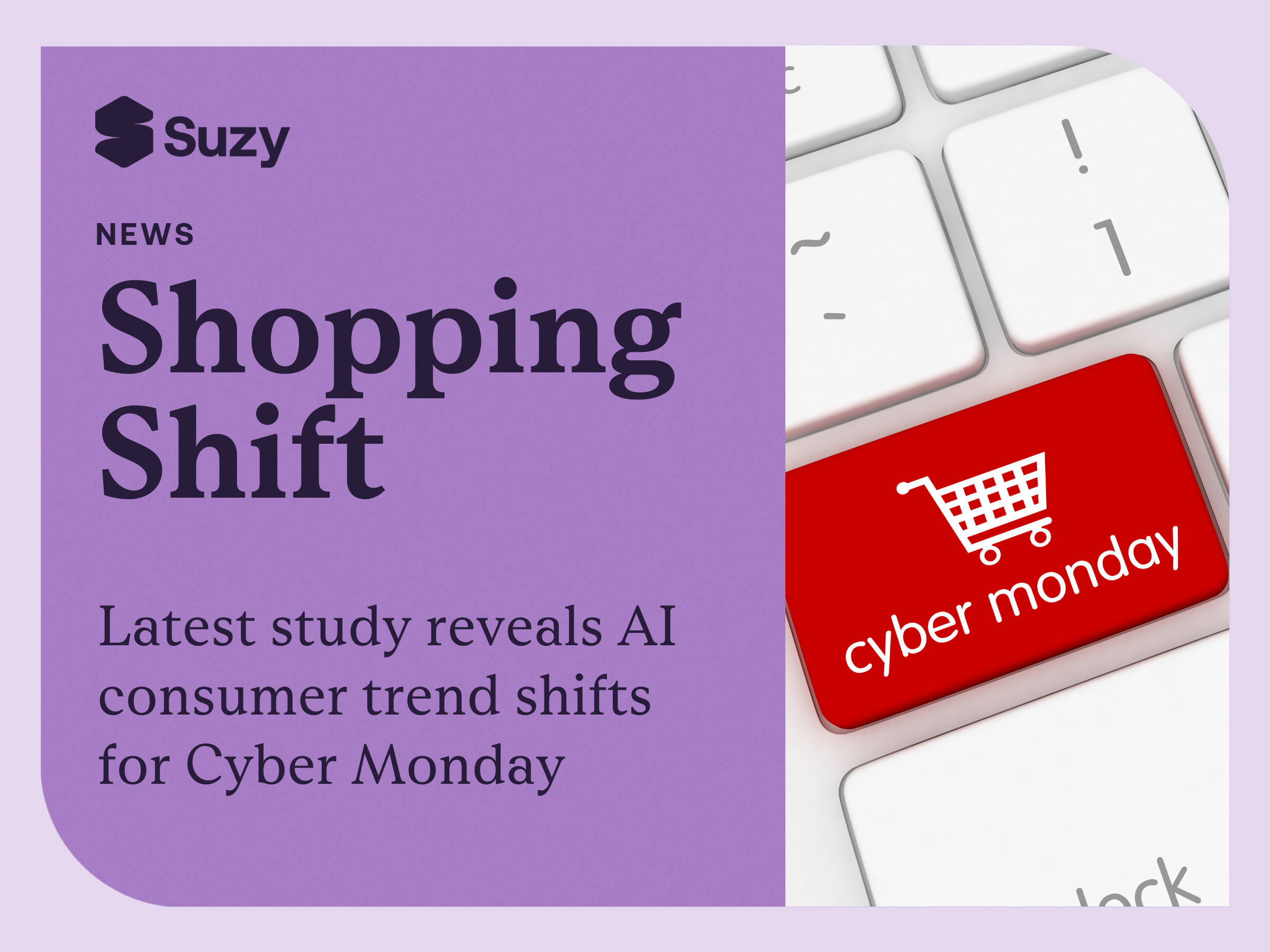By Silvia Veltcheva, Senior Director, Market Research, Suzy
A new era of labeling and accountability
As a consumer and a mom, I often find myself scrutinizing packages and product labels—whether it’s what goes into my fridge, my pantry, or my medicine cabinet. Like many others, I rely on labeling to make healthy, informed choices. But let’s be honest: labeling can often be misleading. Claims like “all natural,” “non-GMO,” or even “sustainable” can feel more like marketing buzzwords than trustworthy information.
I’m not alone. In fact, consumer confusion and a growing demand for transparency have pushed regulatory agencies to rethink how brands communicate product claims. New rules are emerging to eliminate misleading language and create consistency that helps everyday shoppers make smarter decisions.
For brands, however, these regulatory changes bring uncertainty. Will new labels hurt brand trust? Will clearer claims translate into increased loyalty—or consumer skepticism? To confidently answer these questions, companies must lean on agile tools to respond not just to policy, but to the shifting consumer perceptions that come with it.
Regulatory shifts you need to know
Federal agencies change regulatory policies
Part of the mission of agencies like the FTC (Federal Trade Commission) and FDA (Food and Drug Administration) is to ensure that consumers can make informed purchasing decisions. But in today’s marketplace—where climate concerns, health trends, and “clean living” are central to consumer identity—the bar has been raised.
- The Federal Trade Commission (FTC) is in the process of updating its Green Guides, originally issued in 2012, to provide clearer guidance around environmental marketing claims. Terms like “compostable,” “recyclable,” and “sustainable” are under review. The goal of these updates is to make sure brands back up what they say with real evidence.
- Meanwhile, the Food and Drug Administration (FDA) has proposed new labeling requirements focused on key nutritional indicators—such as sodium, added sugars, and saturated fat—and an updated definition of what counts as “healthy.” These changes aim to give shoppers more intuitive, front-of-pack guidance, especially in the face of the growing obesity epidemic, which has resulted in rising public health concerns.
State-level legislation gaining momentum
Beyond the federal push, states like California and Texas are introducing their own rules—going even further than federal standards. California’s recent law restricting certain additives has now been surpassed by Texas’s Senate Bill 25, which mandates warning labels on products that contain over 40 different food additives, including artificial dyes and emulsifiers.
While these regulations are designed to protect consumers, they pose a real challenge for brands. Reformulating products for different states is expensive and impractical—especially since California and Texas together represent over 20% of the U.S. population. For national brands, that means updating product formulations altogether or confronting the risk of carrying a warning label that could damage consumer trust.
Consumers aren’t just confused – they’re cautious
Research shows that awareness of labeling standards varies widely among consumers. One shopper may associate “non-GMO” with superior nutrition, while another sees it as irrelevant. Similarly, “plant-based,” “organic,” and “sustainably sourced” are interpreted through the lens of personal values, lifestyle, and generational outlook. For instance, younger consumers may associate ‘sustainable’ with ethical labor practices, while older shoppers might equate it strictly with environmental packaging. Understanding these layered perceptions is key to crafting effective messaging.
Inconsistent labeling not only leads to confusion—it can breed distrust. When shoppers feel overwhelmed by claims, they may tune them out entirely or start to question a brand’s authenticity.
That’s why brands need to go beyond compliance. They need insight into how their specific audiences interpret and emotionally respond to changes in labels, packaging, and product ingredients.
Labeling mishaps: What happens when brands miscommunicate
There are a number of examples showing the high stakes of getting labeling and pack communication right. In 2020 Bigelow Tea was sued in CA over a claim made on their packaging - “Manufactured in the USA 100%.” The plaintiffs argued that the company’s claim was misleading because it sources its tea leaves and processes the tea from abroad. Bigelow’s stated intention was to convey that the teas were blended, and packaged in the USA - a claim the company updated on its packaging. The mistake was costly for Bigelow - the company reportedly paid $2.4 million in damages to the plaintiffs. This case underscores the legal risks of relying on technical truths that may conflict with consumer interpretation.
The Honest Company also made a costly mistake in its use of ‘natural’ labeling. That’s a case I remember vividly – as a young mom in 2016, I was misled by those labels myself, having purchased baby products at a premium because I believed they were free of harmful ingredients. In the lawsuit, plaintiffs claimed that the ‘natural’ or ‘all-natural’ claims implied the products were safe, non-toxic, and plant-based. However, they reportedly contained synthetic ingredients, some of which were rated ‘hazardous’ by the Environmental Working Group. This and other class action lawsuits over misleading labeling reportedly cost the Honest Company more than $7 million.
These cases reshaped my own understanding of what ‘healthy’ or ‘natural’ means as both a parent and a researcher. They also highlighted how little room there is for ambiguity when consumers are making high-stakes health decisions. They provide real-world examples of the costly implications for brands when consumer trust, regulatory scrutiny, or judicial interpretation diverge from brand intent. If Bigelow had engaged consumers and tested how they parse the “Made in USA 100%” claims, they may have recognized the risk of including these claims on product packaging before investing in the pack redesign and rollout and incurring the costs of the lawsuit.
These missteps aren’t isolated – they point to systemic risk. One that brands should actively seek to mitigate by having their finger on the pulse of the consumer.
Real-time insights with Suzy
At Suzy, we’ve seen firsthand how agile research can help brands respond quickly and confidently to this changing landscape.
One client in the bread and bakery category used Suzy to test consumer reactions to a proposed change in oil formulation. Before investing in reformulation and packaging redesign, they wanted to understand if the switch would raise red flags—or go unnoticed. The research revealed that while most consumers were indifferent, certain health-conscious segments had strong opinions. That insight helped the brand shape messaging that was proactive and reassuring.
Another client in the plant-based food space used Suzy to identify the most compelling claims for vegan and flexitarian consumers. While a claim they favored internally tested well, one referencing a certification was seen as more credible and motivating. That brand went on to A/B test label design and rolled out packaging with the language that resonated best—minimizing confusion and maximizing trial.
The risk of over-labeling
While transparency is essential, there’s also a risk in over-labeling. Too many claims – especially when unverified or redundant – can lead to fatigue or skepticism. Today’s packaging often features a long list of terms that may seem somewhat overlapping to consumers – “non-GMO,” “organic,” “recyclable,” “natural,” “clean label,” and more – all competing for attention on limited label real estate. Additionally, some of them reference different certifications. This can lead to cognitive overload, where shoppers struggle to process the information or, worse, ignore it altogether.
When brands lean too heavily on buzzwords or layer on multiple claims without clear context, they may unintentionally trigger skepticism rather than trust. In some cases, consumers start to question a product’s authenticity or assume the brand is trying too hard to sell virtue over value. This is why it's not just about deciding what to include on the label, but also how much is too much. At Suzy, we help brands navigate this balancing act by testing not only claim preferences, but also the tipping point at which clarity becomes clutter. With agile research, brands can fine-tune messaging to resonate with their target consumers – without overwhelming them.
What brands should do next
1. Audit your claims:
Start by assessing which current claims might be vulnerable under new or upcoming regulations. Terms like “eco-friendly” or “natural” may no longer pass muster.
2. Pre-test messaging:
Before investing in packaging with new labels, test them. Do warning labels reduce trust? Are “clean label” claims interpreted positively or met with skepticism?
3. Segment the response:
What resonates with Gen Z might fall flat with Gen X. What a parent finds reassuring might seem overblown to a single adult. Understanding these nuances is critical in crafting the right approach and designing outreach and communication strategies for your consumers.
4. Track shifting definitions:
Words like “clean,” “natural,” or even “healthy” evolve over time and vary by region, age, and cultural context. Brands need to routinely re-evaluate how these terms are understood in the marketplace to stay aligned with consumer expectations.
Suzy’s platform allows you to run micro-targeted tests—whether it’s Gen Z parents in urban markets or flexitarians in the Midwest. You can simulate label changes, test reformulation language, and optimize packaging claims in days, not weeks. Investing in consumer research upfront, can save millions of dollars down the road.
Regulation isn’t the end – It’s a research opportunity
The evolving regulatory landscape isn’t something to fear – it’s an opportunity for brands to deepen trust, clarify values, and connect more meaningfully with consumers.
Policy will continue to change. But by combining regulatory awareness with real-time consumer insight, brands can make informed, agile decisions that balance compliance with creativity.
With Suzy, you don’t have to guess how your audience will respond. You can ask – and act – with confidence.
.webp)






.png)
